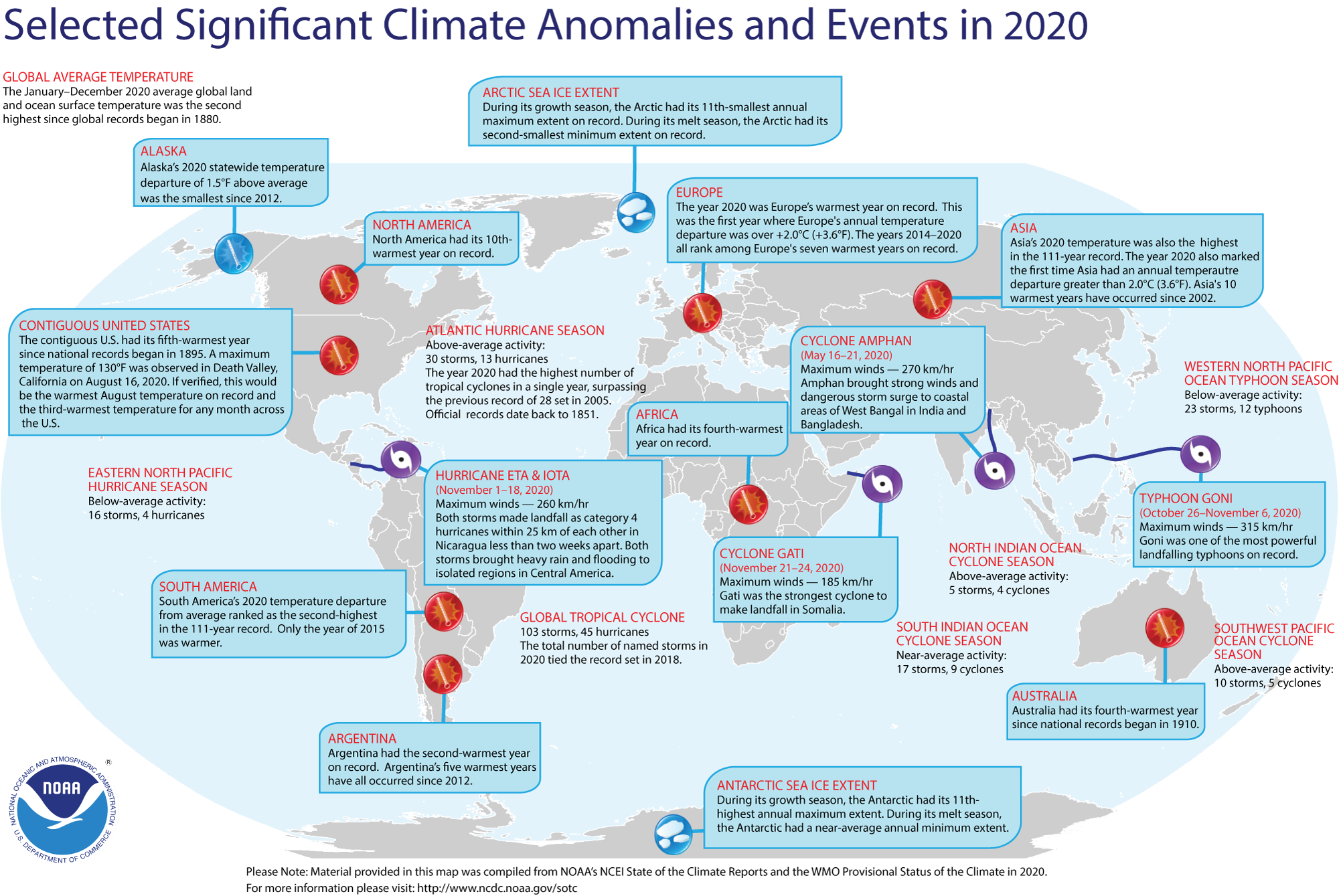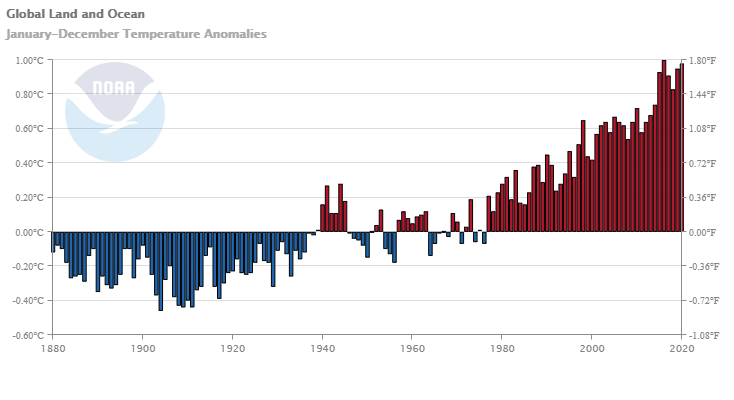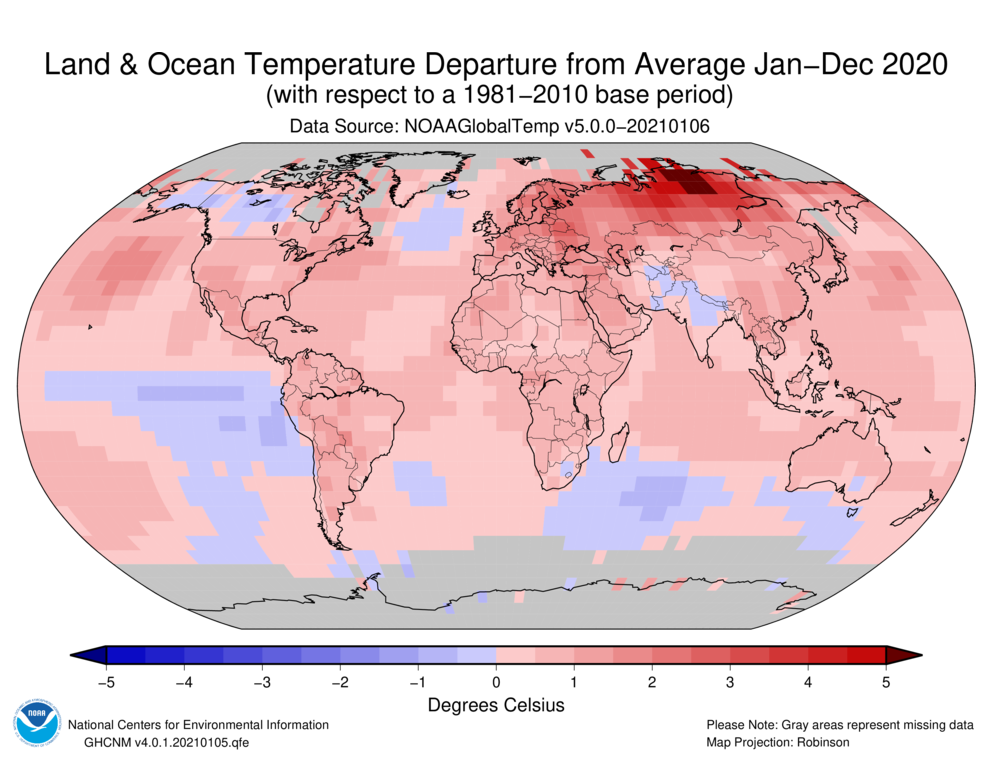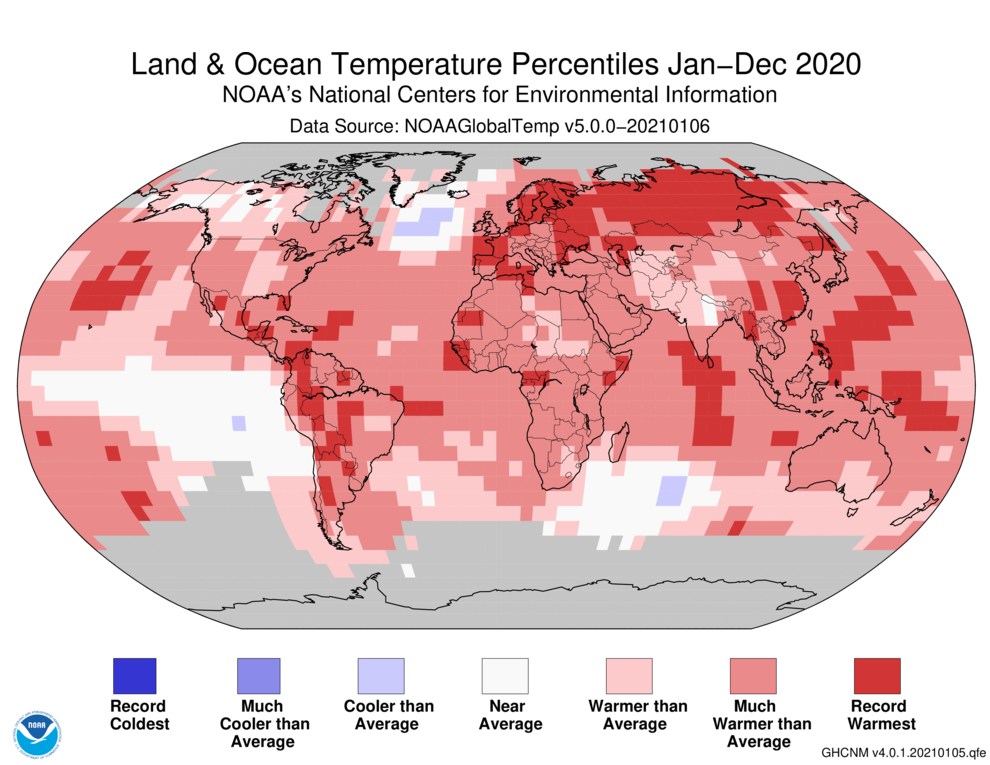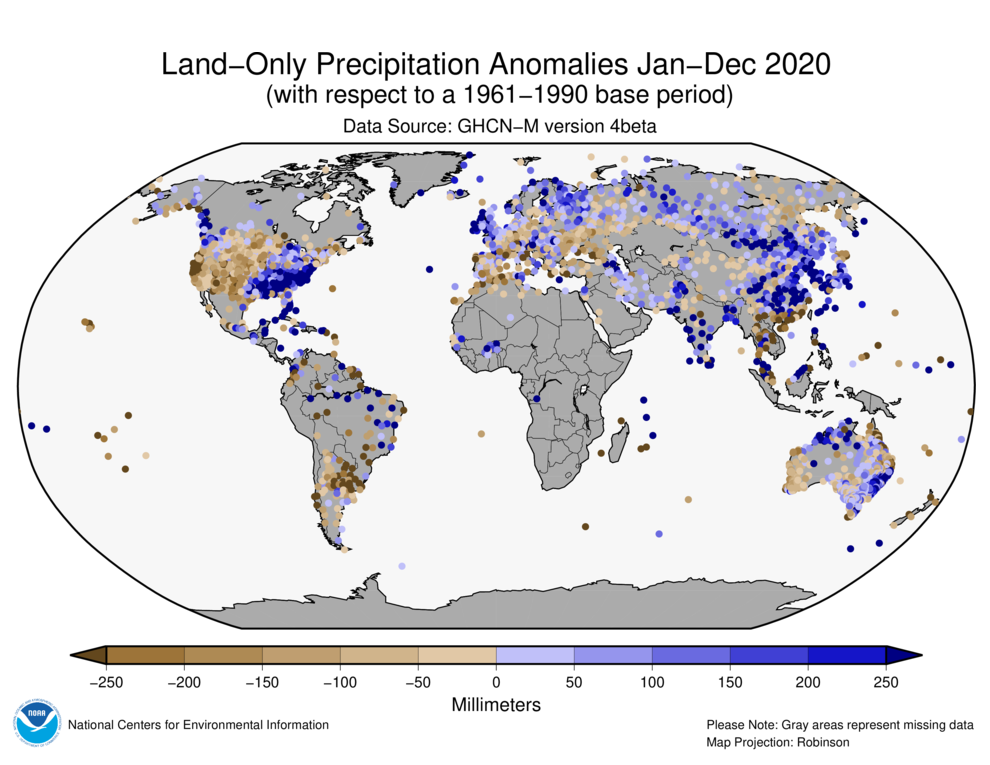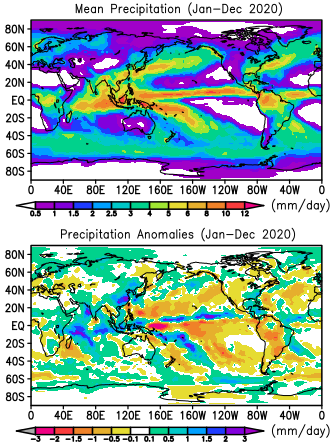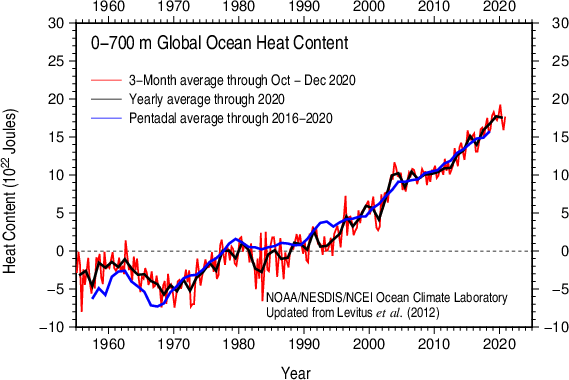Global Temperatures
The year began in ENSO-neutral conditions, transitioning to La Niña by August 2020. During the year, each monthly temperature for the months of January through November ranked among the four warmest on record for their respective months. While the months of January, May, and September were record warm. Meanwhile, the month of December had a global land and ocean surface temperature departure of 0.78°C (1.40°F) above the 20th century average—this was the smallest monthly temperature departure during 2020 and was the eighth warmest December on record.
With a slightly cooler end to the year, the year 2020 secured the rank of second warmest year in the 141-year record, with a global land and ocean surface temperature departure from average of +0.98°C (+1.76°F). This value is only 0.02°C (0.04°F) shy of tying the record high value of +1.00°C (+1.80°F) set in 2016 and only 0.03°C (0.05°F) above the now third warmest year on record set in 2019. The seven warmest years in the 1880–2020 record have all occurred since 2014, while the 10 warmest years have occurred since 2005. The year 1998 is no longer among the 10 warmest years on record, currently ranking as the 11th warmest year in the 141-year record. The year 2020 marks the 44th consecutive year (since 1977) with global land and ocean temperatures, at least nominally, above the 20th century average.
The decadal global land and ocean surface average temperature anomaly for 2011–2020 was the warmest decade on record for the globe, with a surface global temperature of +0.82°C (+1.48°F) above the 20th century average. This surpassed the previous decadal record (2001–2010) value of +0.62°C (+1.12°F).
The global annual temperature has increased at an average rate of 0.08°C (0.14°F) per decade since 1880 and over twice that rate (+0.18°C / +0.32°F) since 1981.
The 2020 Northern Hemisphere land and ocean surface temperature was the highest in the 141-year record at +1.28°C (+2.30°F) above average. This was 0.06°C (0.11°F) higher than the previous record set in 2016. Meanwhile, the annual Southern Hemisphere land and ocean surface temperature was the fifth highest on record.
| January–December | Anomaly | Rank (out of 141 years) | Records | ||||
|---|---|---|---|---|---|---|---|
| °C | °F | Year(s) | °C | °F | |||
| Global | |||||||
| Land | +1.59 ± 0.14 | +2.86 ± 0.25 | Warmest | 1st | 2020 | +1.59 | +2.86 |
| Coolest | 141st | 1884 | -0.71 | -1.28 | |||
| Ocean | +0.76 ± 0.16 | +1.37 ± 0.29 | Warmest | 3rd | 2016 | +0.79 | +1.42 |
| Coolest | 139th | 1904 | -0.46 | -0.83 | |||
| Land and Ocean | +0.98 ± 0.15 | +1.76 ± 0.27 | Warmest | 2nd | 2016 | +1.00 | +1.80 |
| Coolest | 140th | 1904 | -0.46 | -0.83 | |||
| Northern Hemisphere | |||||||
| Land | +1.74 ± 0.16 | +3.13 ± 0.29 | Warmest | 1st | 2020 | +1.74 | +3.13 |
| Coolest | 141st | 1884 | -0.80 | -1.44 | |||
| Ocean | +0.99 ± 0.16 | +1.78 ± 0.29 | Warmest | 1st | 2020 | +0.99 | +1.78 |
| Coolest | 141st | 1904 | -0.52 | -0.94 | |||
| Land and Ocean | +1.28 ± 0.15 | +2.30 ± 0.27 | Warmest | 1st | 2020 | +1.28 | +2.30 |
| Coolest | 141st | 1893, 1904, 1907 | -0.48 | -0.86 | |||
| Southern Hemisphere | |||||||
| Land | +1.21 ± 0.13 | +2.18 ± 0.23 | Warmest | 2nd | 2019 | +1.33 | +2.39 |
| Coolest | 140th | 1917 | -0.73 | -1.31 | |||
| Ocean | +0.58 ± 0.16 | +1.04 ± 0.29 | Warmest | 5th | 2016 | +0.70 | +1.26 |
| Coolest | 137th | 1909, 1911 | -0.43 | -0.77 | |||
| Ties: 2018 | |||||||
| Land and Ocean | +0.68 ± 0.15 | +1.22 ± 0.27 | Warmest | 5th | 2016 | +0.77 | +1.39 |
| Coolest | 137th | 1911 | -0.44 | -0.79 | |||
| Arctic | |||||||
| Land and Ocean | +2.24 ± 0.17 | +4.03 ± 0.31 | Warmest | 2nd | 2016 | +2.34 | +4.21 |
| Coolest | 140th | 1902 | -1.44 | -2.59 | |||
The 1901–2000 average combined land and ocean annual temperature is 13.9°C (57.0°F), the annually averaged land temperature for the same period is 8.5°C (47.3°F), and the long-term annually averaged sea surface temperature is 16.1°C (60.9°F).
Ten Warmest Years (1880–2020)
The following table lists the global combined land and ocean annually averaged temperature rank and anomaly for each of the 10 warmest years on record.
| Rank 1 = Warmest Period of Record: 1880–2020 |
Year | Anomaly °C | Anomaly °F |
|---|---|---|---|
| 1 | 2016 | 1.00 | 1.80 |
| 2 | 2020 | 0.98 | 1.76 |
| 3 | 2019 | 0.95 | 1.71 |
| 4 | 2015 | 0.93 | 1.67 |
| 5 | 2017 | 0.91 | 1.64 |
| 6 | 2018 | 0.83 | 1.49 |
| 7 | 2014 | 0.74 | 1.33 |
| 8 | 2010 | 0.72 | 1.30 |
| 9 | 2013 | 0.68 | 1.22 |
| 10 | 2005 | 0.67 | 1.21 |
Regional Temperatures
The following information was compiled from previous NCEI monitoring reports and public reports by National Hydrometeorological Services (NHMSs; peers of the U.S. National Weather Service).
The year 2020 was characterized by warmer-than-average temperatures across much of the globe. Record high annual temperatures over land and ocean surfaces were measured across parts of Europe, Asia, southern North America, South America, and across parts of the Atlantic, Indian, and Pacific oceans. However, no land or ocean areas were record cold for the year.
North America
North America's temperature was 1.16°C (2.09°F) above the 1910–2000 average—the 10th warmest year in the 111-year continental record. Nine of North America's 10 warmest years have occurred since 2001, with the year of 1998 among the 10 warmest years on record. The year 2016 is North America's warmest year on record with a temperature departure of +1.92°C (3.46°F). The year 2020 marked North America's 24th consecutive year with temperatures, at least nominally, above average. The yearly temperature for North America has increased at an average rate of 0.13°C (0.23°F) per decade since 1910; however, the average rate of increase is a little more than twice as great (+0.29°C / +0.52°F per decade) since 1981.
- According to the Government of Canada, the year 2020 was a year of destructive and impactful weather with nine weather events that had a preliminary total insured loss estimate close to 2.5 billion Canadian dollars. One of Canada's top 10 weather events was the unusually warm temperatures across the central and eastern Canada in May. Eastern Canada's summer 2020 was the warmest summer since 2012 and ranked among the top five warm summer in the nation's 73-year record. Of note, Montreal had a maximum temperature of 36.6°C (97.9°F) on May 27, 2020—the hottest May temperature and the second highest ever on record for Montreal. The temperature of 37.7°C (99.9°F) set on August 1, 1975 was the hottest. In addition, many records were set during the months of June and July.
- Please see the U.S. national annual report for information on the 2020 climate conditions across the U.S.
- The Hawaiian region had a temperature departure of +0.65°C (+1.17°F), which is lowest annual temperature departure for the region since 2013 and the 11th warmest year since continental records began in 1910. Although the temperature departure for the year was lower than recent years, it marked the eighth the consecutive year with temperatures above average.
- According to Mexico's CONAGUA, the months of April through November (no December 2020 data was available at the time of this write-up) had a temperature that ranked among the six highest for their respective months. Of note, the months of May, July, and November were record warm.
- The Caribbean region had its second warmest year on record, with a temperature departure of 0.98°C (1.76°F) above average. This was only 0.05°C (0.09°F) shy of tying the record-warm year set in 2016. The year 2020 marked the 31st consecutive year where the Caribbean region had above-average temperatures. According to the World Meteorological Organization, a heat wave affected parts of the Caribbean region in April 2020. A national record was set in Cuba when the maximum temperature soared to 39.7°C (103.5°F) on April 12 at Veguitas.
South America
South America had its second warmest year on record with a temperature departure from average of +1.40°C (+2.52°F). This value is only 0.03°C (0.05°F) cooler than the record-warm year in 2015. Nine of South America's 10 warmest years have occurred since 2009, with the five warmest years all occurring since 2015. This was also the 44th consecutive year with temperatures above average. The yearly temperature for South America has increased at an average rate of 0.14°C (0.25°F) per decade since 1910; however, the average rate of increase is nearly double that value (+0.25°C / +0.45°F per decade) since 1981.
- The year 2020 was Argentina's second warmest year on record with a national temperature departure of +0.63°C (+1.13°F). Only the year 2017 was warmer at 0.68°C (1.22°F) above average. According to Argentina's National Weather Service, Argentina's five warmest years have occurred since 2012.
- Pending confirmation from the WMO, a new all-time high maximum temperature was recorded in Antarctica when temperatures rose to 18.4°C (65.1°F) at Esperanza Base on 6 February 2020. This temperature surpassed the previous record of 17.5°C (63.5°F) set on 24 March 2015. Records began in 1961 for this location. The Marambio Base set a new temperature record for February when temperatures soared to 15.7°C (60.4°F) on 6 February 2020, surpassing the previous record of 13.8°C (56.8°F) set on 24 February 2013. The all-time high maximum temperature observed in the Marambio Base is 17.4°C (63.3°F) set on 23 March 2015.
Europe
Europe had its warmest year on record at 2.16°C (3.89°F) above average, surpassing the previous record set in 2018 by 0.28°C (0.50°F). This was also the first year where Europe's annual temperature departure was over +2.0°C (+3.6°F). The years 2014 through 2020 all rank among Europe's seven warmest years on record, while the top 10 warmest years have occurred since 2000. The year 2020 marked the 24th consecutive year with above-average temperature departures. Europe's annual temperature has increased at an average rate of 0.15°C (0.27°F) per decade since 1910; however, it has more than tripled to 0.47°C (0.85°F) since 1981.
- The United Kingdom had its third warmest year on record since national records began in 1884, with a national average that was 0.8°C (1.44°F) above average. Only the years of 2006 and 2014 were warmer. According to the UK Met Office, the ten warmest years for the UK have occurred in the 21st century.
- The Netherland's annual temperature of 11.7°C (53.1°F) tied with 2014 as the warmest year since national records began in 1901. According to the Netherland's Meteorological Institute, the year 2020 marked the seventh consecutive year with above-average national temperatures.
- Sweden and Finland had their warmest year on record.
Africa
With a yearly continental average temperature of 1.19°C (2.14°F) above average, Africa had its fourth warmest year (tied with 2015) in the 111-year record. Africa's 10 warmest years have all occurred since 2005, with the five warmest occurring since 2010. The years 2010 and 2016 tied as Africa's warmest year on record at 1.44°C (2.59°F) above average. Africa's annual temperature has increased at an average rate of 0.13°C (0.23°F) per decade since 1910; however, it has more than doubled to 0.30°C (0.54°F) since 1981.
Asia
Asia also had its warmest year on record, with a temperature departure of 2.07°C (3.73°F) above the 1910–2000 average. This was 0.35°C (0.63°F) above the now second warmest year set in 2015. The year 2020 also marked the first time Asia had an annual temperature departure greater than 2.0°C (3.6°F). Asia's 10 warmest years have occurred since 2002, while the five warmest years have all taken place since 2007. This was also the 33rd consecutive year that Asia had above-average temperatures. Asia's trend during the 1910–2020 period was +0.17°C (+0.31°F) per decade; however, the 1981–2020 trend is twice the longer-term trend (+0.37°C / +0.67°F).
- According to India's Meteorological Department, India's annual temperature departure of +0.29°C (+0.52°F) was the eighth highest since national records began in 1901. India's warmest year took place in 2016 with a temperature departure of +0.71°C (+1.28°F). Twelve of India's 15 warmest years have occurred since 2006.
- Hong Kong's 2020 temperature departure of +1.1°C (+1.98°F) was the second highest since records began in 1884.
Oceania
Oceania had its fourth warmest year on record at 1.15°C (2.07°F) above average. Only the years of 2013, 2016, and 2019 were warmer. Oceania's 10 warmest years have occurred since 1998, while the five warmest year have all occurred since 2005. The year 2020 also marked the 36th consecutive year with temperatures above average across Oceania. The 1910–2020 trend for Oceania was +0.12°C (+0.22°F) per decade; however, the trend is close to twice that during the 1981–2018 period (+0.21°C / +0.38°F per decade).
- With a national mean temperature departure from average of 1.15°C (2.07°F) above the 1961–1990 average, Australia had its fourth warmest year since national records began in 1910. Australia's decadal (2011–2020) temperature departure of 0.94°C (1.69°F) was the highest decadal temperature on record for the nation, surpassing the previous record set in 2001–2010 by 0.33°C (0.59°F).
Precipitation
As indicated by the Global Percent of Normal Precipitation and Precipitation Percentiles maps below and as is typical, many stations were wet for the year, while many stations were dry. Also, as discussed below, extreme precipitation and drought events occurred across the world.
- See the U.S. National Annual Climate and U.S. Annual Drought reports for additional information on drought and notable precipitation extremes across the U.S. during 2020.
- Spain had a wet March and April. Several locations set new daily and precipitation records and locations across the Mediterranean coast and some parts of the Balearic Islands had triple their April normal precipitation.
- According to the WMO, parts of South America experienced drought during the year, with the most affected across northern Argentina, Paraguay and western border areas of Brazil. Parts of northeast Argentina had their driest January–August on record.
- Tropical Storm Cristobal, the earliest third tropical storm on record in the Atlantic Basin, made landfall in eastern Mexico on June 3. Cristobal brought torrential rains that prompted floods and landslides across southern Mexico and parts of Guatemala. Over 200 houses were damaged and over 500 people were affected.
- According to Reliefweb, the Abidjan Department of Cote d'Ivoire had heavy rains that triggered flash floods on June 25. Several major road infrastructures were flooded and damaged. The event affected over 8,000 people.
- Monsoon rains at the start of the month of July triggered floods and landslides across central and western Nepal. According to the Disaster Risk Reduction Authority in Nepal, over 110 fatalities were reported and over 600 families were affected. Extensive damages were also reported due to the floods and landslides, with about 300 houses damaged and roads blocked by debris.
- Torrential rain fell across parts of Bangladesh in July, causing more than 90 fatalities and affecting 4.7 million people. According to ReliefWeb, over 980,000 homes and 150,000 hectares of paddy fields were inundated by floods. It was reported that 24% of the country was flooded.
- Tropical Cyclone Gati was the strongest cyclone to make landfall in Somalia as an equivalent Category 2 hurricane on the Saffir-Simpson scale. According to the World Meteorological Organization, prior to Gati, there was no historical record of a hurricane strength system making landfall in Somalia.
- Argentina's annual precipitation total was 16.7% below average. This was Argentina's driest year since 1995 and the fifth driest since national records began in 1961.
- The United Kingdom's annual precipitation total of 1308 mm (51.5 mm) or 114% above average. This was the sixth wettest year on record.
- February 2020 was drier-than-average across much of New Zealand, with severe meteorological drought widespread across parts of northern New Zealand. According to NIWA, several locations set a new record for longest dry spell [consecutive days with less than 1 mm (0.04 inch) of rain] in February.
Global Precipitation Climatology Project (GPCP)
The following analysis is based upon the Global Precipitation Climatology Project (GPCP) Interim Climate Data Record. It is provided courtesy of the GPCP Principal Investigator team at the University of Maryland.
The Global Precipitation Climatology Project (GPCP) monthly data set is a long-term (1979-present) analysis (Adler et al., 2018) using a combination of satellite and gauge information. An interim GPCP analysis completed within ~10 days of the end of the month allows its use in climate monitoring.
The estimated mean global precipitation for 2020 is estimated from the GPCP Monthly analyses as 2.70 mm d-1, almost exactly the 40-year climatological mean of 2.69. The mean values for ocean and land are 2.90 and 2.28 mm d-1, respectively. The mean precipitation map for 2020 (Fig. 1-top panel) shows the usual maxima of the tropics and mid-latitudes and dry zones in the sub-tropics and generally looks very similar to the long-term climatology (not shown). However, there are significant anomalies for 2020 from the long-term (1979–2020) as seen in the bottom panel of Fig. 1. Clearly seen around the tropical belt are positive anomalies along the ITCZ clearly over ocean in the Indian, Pacific and Atlantic Oceans. To the north and south of the oceanic ITCZ features are large areas of negative anomalies in the sub-tropics, except in the Indian Ocean. Therefore, a general wet ITCZ area is getting wetter in 2020 with accompanying dry zones getting drier.
Over tropical land results are mixed with positive anomalies over the Maritime Continent, while South America is dominated by drier than usual conditions associated with drought. Australia has a mixed pattern recovering in many places in 2020 from the drought and wildfires of 2019. Africa has mixed positive and negative features. North America displays generally dry conditions over its western half extending down to Central America; wet conditions dominate to the east across the Caribbean, Gulf of Mexico and into the Southeast U.S. Some of this relative wetness is associated with an active tropical cyclone season. The dryness in western North America and over South America is clearly connected to dryer than normal features over the North and South Pacific. Drought over these land areas in the Americas was a key attribute of 2020. Similar dry features are also evident over the Atlantic.
A variable anomaly pattern is evident over Europe, but with drier conditions prevailing in the western regions. The strongest positive anomaly over land for 2020 is evident in eastern China, the scene of devastating and long-lasting floods primarily during the summer months.
The year 2020 began with El Niño conditions for the first three months, then roughly neutral conditions until La Niña evolved and affected the last three months. Figure 2 shows the evolution of the anomaly patterns through the year. Because the ENSO effect is muted for the whole year, the annual anomaly pattern (Fig. 1) may be more affected by inter-decadal variations and changes related to global warming. However, for the first three months of the year, during El Niño conditions, there is the usual excess rainfall in the central Pacific along the Equator and generally drier than normal conditions over the Maritime Continent. Other features, for example, over Australia, the intense dry feature in South America and the Indian Ocean positive anomaly are likely related to the El Niño conditions. The July–September figure (Fig.2c) displays the small, but very intense positive anomaly associated with the China floods. In the fourth quarter, now with La Niña conditions, the central Pacific reverses from the positive anomaly to intense negative and the Maritime Continent goes positive. Other features mentioned also reverse. Over the U.S. mostly positive anomalies early on change to mostly negative near the end of the year as expected under El Niño/La Niña shifting conditions. Rainfall excess with tropical cyclones for this year can also be seen in the Caribbean and South China Sea in the fourth quarter. Outside the clearly ENSO-affected regions, the large-scale patterns, e.g., over the subtropics of the Pacific and the Atlantic stay roughly the same during the year, perhaps indicating longer-term effects.
In addition to the effects of inter-annual forcings, such as the SST variations associated with ENSO, longer term processes such as inter-decadal forcings (e.g., Pacific Decadal Oscillation [PDO]) and global warming (GW) may be changing the pattern of precipitation anomalies during the 40-year GPCP record. Figure 3 links the anomalies for 2020 with the precipitation trend pattern over the previous 42 years. The trend pattern (top panel) shows strong increases along the Pacific ITCZ, in the tropical Atlantic and Indian Ocean, with decreases in over the sub-tropical oceans. Features of the same sign are noted generally in many of the same regions in the 2020 anomalies, indicating a 2020 reinforcement of the 40-year trend. Over the latitude band from 50N-50S the area-weighted correlation between the trend field and the 2020 anomaly field is +0.30, the positive correlation indicating that general reinforcement in 2020 of the longer-term changes occurring in the global precipitation pattern. This type of connection is evident over the southwest U.S.
The global total precipitation seems to be increasing very slowly according to the GPCP analysis, but the magnitude of the trend is not strongly significant. From the trend map in Fig. 3, however, significant regional trends are happening, but in a very geographically complicated way. Two latitude bands do show some greater contiguity of trend sign, specifically the zone between 0-10°N, covering most of the ITCZ and the mid-latitude zone between 30-40°N. Figure 4 (top panel) shows the time history of the anomaly values in these zones (ocean and land combined) showing an increase in the low-latitude zone and a decrease in the mid-latitude peak. The difference between the two zones (bottom panel) emphasizes that the gradient between these two zones is increasing with time and this is related mainly to GW, although inter-decadal effects are probably also present. Since the mid-latitude zone (30-40°N) is along the south edge of the storm track and covers parts of the sub-tropical dry region its mean value is significantly lower than the mean ITCZ (0-10°N) value and this can be interpreted as a wet-getting-wetter, dry-getting drier type of event, on a large scale. However, the values for 2020 are actually close to the long-term means and the inter-annual variability can be seen to be large compared to the trend with relative maxima associated with El Ninos in 1983, 1998 and 2015.
Ocean Heat Content
Ocean Heat Content (OHC) is essential for understanding and modeling global climate since > 90% of excess heat in the Earth's system is absorbed by the ocean. Further, expansion due to increased ocean heat contributes to sea level rise. Change in OHC is calculated from the difference of observed temperature profiles from the long-term mean.
| Basin | 0-700 meters | Rank (1955-2023) | |||||
|---|---|---|---|---|---|---|
| Entire Basin | Northern Hemisphere | Southern Hemisphere | ||||
| Atlantic | 7.459 | 5th | 4.057 | 5th | 3.402 | 3rd |
| Indian | 3.427 | 11th | 0.922 | 3rd | 2.506 | 13th |
| Pacific | 6.638 | 5th | 3.335 | 4th | 3.302 | 7th |
| World | 17.524 | 5th | 8.314 | 4th | 9.210 | 7th |
| Source: Basin time series of heat content | ||||||
The annual global ocean heat content (OHC) for 2020 is relatively unchanged from 2019, previously the highest annual OHC on record: while the 0–700m OHC is slightly lower, the 0–2000m annual global OHC is slightly higher than in 2019. The six highest OHC have all occurred in the last six years (2015–20). During 2020, the heating was distributed throughout the world's oceans, with higher rates of warming in the northern and southern Atlantic and in localized zones of the Pacific, Indian, and Southern Oceans.
The ocean heating is irrefutable and a key measure of the Earth's energy imbalance: the excess greenhouse gases in the air trap more heat inside the climate system and drives global warming. More than 90% of the heat accumulates in the ocean because of its large heat capacity, and the other heating is manifested in warming the atmosphere, warming and drying land, and melting land and sea ice. There are no reasonable alternatives aside from the human emissions of heat-trapping gases (IPCC 2001, 2007, 2013, 2020; USGCRP 2017).
For additional information on the 2020 OHC, please see the paper titled Upper Ocean Temperatures Hit Record High in 2020.
References
- Adler, R., G. Gu, M. Sapiano, J. Wang, G. Huffman 2017. Global Precipitation: Means, Variations and Trends During the Satellite Era (1979-2014). Surveys in Geophysics 38: 679-699, doi:10.1007/s10712-017-9416-4
- Adler, R., M. Sapiano, G. Huffman, J. Wang, G. Gu, D. Bolvin, L. Chiu, U. Schneider, A. Becker, E. Nelkin, P. Xie, R. Ferraro, D. Shin, 2018. The Global Precipitation Climatology Project (GPCP) Monthly Analysis (New Version 2.3) and a Review of 2017 Global Precipitation. Atmosphere. 9(4), 138; doi:10.3390/atmos9040138
- Gu, G., and R. Adler, 2022. Observed Variability and Trends in Global Precipitation During 1979-2020. Climate Dynamics, doi:10.1007/s00382-022-06567-9
- Huang, B., Peter W. Thorne, et. al, 2017: Extended Reconstructed Sea Surface Temperature version 5 (ERSSTv5), Upgrades, validations, and intercomparisons. J. Climate, doi: 10.1175/JCLI-D-16-0836.1
- Huang, B., V.F. Banzon, E. Freeman, J. Lawrimore, W. Liu, T.C. Peterson, T.M. Smith, P.W. Thorne, S.D. Woodruff, and H-M. Zhang, 2016: Extended Reconstructed Sea Surface Temperature Version 4 (ERSST.v4). Part I: Upgrades and Intercomparisons. J. Climate, 28, 911-930, doi:10.1175/JCLI-D-14-00006.1.
- Menne, M. J., C. N. Williams, B.E. Gleason, J. J Rennie, and J. H. Lawrimore, 2018: The Global Historical Climatology Network Monthly Temperature Dataset, Version 4. J. Climate, in press. https://doi.org/10.1175/JCLI-D-18-0094.1.
- Peterson, T.C. and R.S. Vose, 1997: An Overview of the Global Historical Climatology Network Database. Bull. Amer. Meteorol. Soc., 78, 2837-2849.
- Vose, R., B. Huang, X. Yin, D. Arndt, D. R. Easterling, J. H. Lawrimore, M. J. Menne, A. Sanchez-Lugo, and H. M. Zhang, 2021. Implementing Full Spatial Coverage in NOAA's Global Temperature Analysis. Geophysical Research Letters 48(10), e2020GL090873; doi:10.1029/2020gl090873.
 NOAA's National Centers for Environmental Information
NOAA's National Centers for Environmental Information
